Important Dates

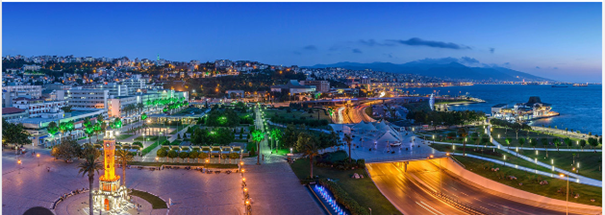
Izmir is a metropolitan city in the western extremity of Turkey and the third most populous city in Turkey, after İstanbul and Ankara.
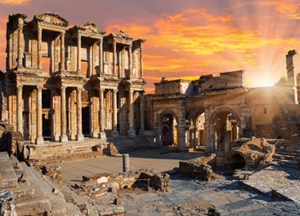
Once the ancient city of Smyrna, İzmir is now a modern, developed, and busy commercial center, set around a huge bay and surrounded by mountains. The broad boulevards, glass-fronted buildings and modern shopping centers are dotted with traditional red-tiled roofs, the 18th century market, and old mosques and churches, although the city has an atmosphere more of Mediterranean Europe than traditional Turkey.
İzmir owes its position as an economically and socially dynamic city to its location, climate and the fact that it has been a home to many different cultures and religions. Persians, Ancient Greeks, Assyrians, Romans, Byzantines and Ottomans are just a few of the dozens of different civilizations that the city has hosted throughout its long history.
In classical antiquity the city was known as Smyrna. Izmir has almost 4,000 years of recorded urban history and possibly even longer as an advanced human settlement. Set in an advantageous location at the head of a gulf in a deep indentation midway along the western Anatolian coast, the city has been one of the principal mercantile cities of the Mediterranean Sea for much of its history. Its port is Turkey's primary port for exports in terms of the freight handled and its free zone, a Turkish-U.S. joint-venture established in 1990, is the leader among the twenty in Turkey. For more information you can visit:
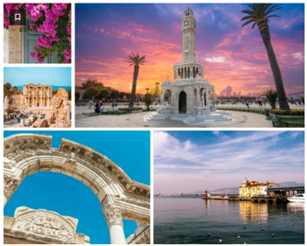
https://www.izmir.bel.tr/YuklenenDosyalar/Yayinlar/0_20072018_044807_tourisminizmir_eng.pdf
https://www.izmir.bel.tr/en/Izmir/14
The prominent information, districts and other attractions in and around Izmir are listed below in alphabetical order:

AGORA:
Revealed in central Izmir during excavations carried out in 1932-1941 in the district of Namazgah. covering an area of 120 x 80 m, the agora throws invaluable light on Roman period Izmir. it was not only a market place, but the location of public institutions and the Temple of Zeus. The agora is open to the public between 9.00 -12.00 and 13.00 -18.00. The statues found here are on exhibit in Izmir Archaeological Museum.
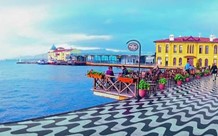
ALSANCAK:
A select neighborhood with a unique character in modern Izmir. Stretching from the waterfront esplanade inland. Most of the area has been transformed into a pedestrian precinct, so there is no traffic to disturb shoppers and strollers. The streets lined by modern buildings and attractive shops lead onto the square where Alsancak station stands. Dating from 1858 the colonial architecture of the station distinguishes it in style from the rest of the city. Trains to Buca, Aydin and Denizli depart from here.
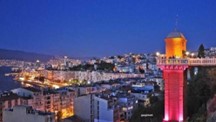
ASANSOR:
The city's famous public elevator, and a symbol of Izmir. This elevator links Mithatpasa street below with Halil Rifat Pasa street at the summit of the precipitous hill. It was built in 1907 and restored by the municipality in 1993. The upper terrace has a breathtaking view over the city and the bay. Here there is an Open-air cafe, a restaurant and a Genoese tavern.
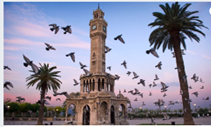
CLOCK TOWER:
Another symbol of the city, this picturesque clock tower in Konak Meydan was built in 1901 to commemorate the 25th anniversary of Abduhamit II's accession to the throne. The clock itself was a gift of Emperor Wilhelm II of Germany. The 25 m high tower is currently being restored.
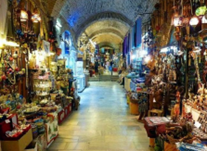
KEMERALTI:
The old fashioned shopping district of Izmir, consisting of narrow streets winding their way from Konak towards central Izmir around Anafartalar Caddesi. Here you can find jewelers, drapers, shoemakers, and shops specializing in all kinds of goods from leather to olives and cheese. The atmosphere of an earlier century still pervades the buildings here, with their distinctive 19th century doorways and roof tiles.
The Urla Vineyard Trail
The Closest Wine Route to Izmir - Just a 30 min Drive west from Downtown Izmir or the Izmir Airport (ADB) - The Urla Vineyard Trail
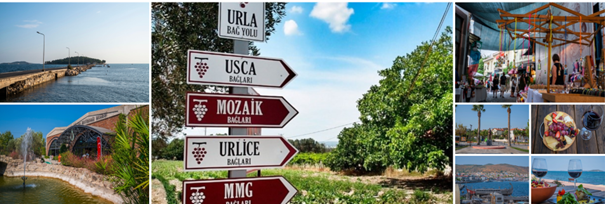
The Urla peninsula sticking out westward from Izmir into the Aegean sea has been the home to outstanding wines since at least the Roman Empire. During those days their excellent wines were yet another victim of Domitian's decree to destroy vineyards and replace them with grain. This was a similar culture shift that happened in the early 20th century when population transition in the area saw many vineyards replaced.
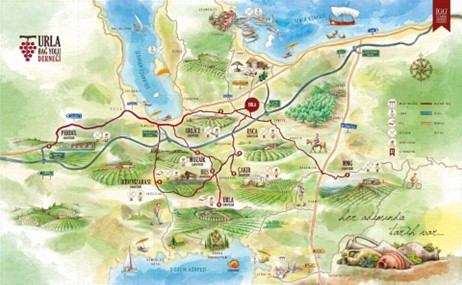
The vast majority of Turkey's vineyards and grapes are grown within a hundred or so kilometers of Izmir. The moderate winters and hot but not overpowering summers are a wonderful climate for grapes. Especially the bold reds and the very distinctly flavorful Bornova Misket - a white wine you must try.
Most of the wineries along the Urla Vineyard Road were established in the late 90's and early 2000's. So the vines are getting to be pretty diverse, with deeping roots and more experience among the winemakers. Plus the young, hip, energetic populace of Izmir have kept the area growing and developing notable restaurants
EPHESUS:
An ancient city three km from the town of Selcuk south of Izmir. During both the Hellenistic and Roman periods Ephesus was the most important port and cultural center of the eastern world. The remains of

the city are still spellbinding today. The magnificent temples, public buildings, villas and streets of Ephesus have been excavated and restored by the Austrian Archaeological Institute, and it requires little effort to imagine the city as it was in its heyday.
PERGAMUM:

The remains of this magnificent ancient city are situated north of Imir. Founded in the early 3rd century BC, Pergamum was the most powerful and extensive kingdom of Western Anatolia throughout the Hellenistic period. Parchment is thought to have been invented here. On the hill which rises steeply in the center of Pergamum is the Acropolis and the world's steepest amphitheatre with seating for 16,000 people. Dionysus. The splendid altar of Zeus at the entrance of the Acropolis was taken to Berlin Museum by Carl Humann in 1871. A flight of 20 steps leads up to this remarkable structure, which dwarfs the room at Berlin Museum, as it awaits expectantly the day when it will be released from confinement and return to its hilltop site in Pergamum. The ruins of the Asclepion on the plain below reveal almost all the original features as a result of the excavations. Named after the god of medicine ,Asclepios, this complex was one of the foremost health centers of the ancient world.

